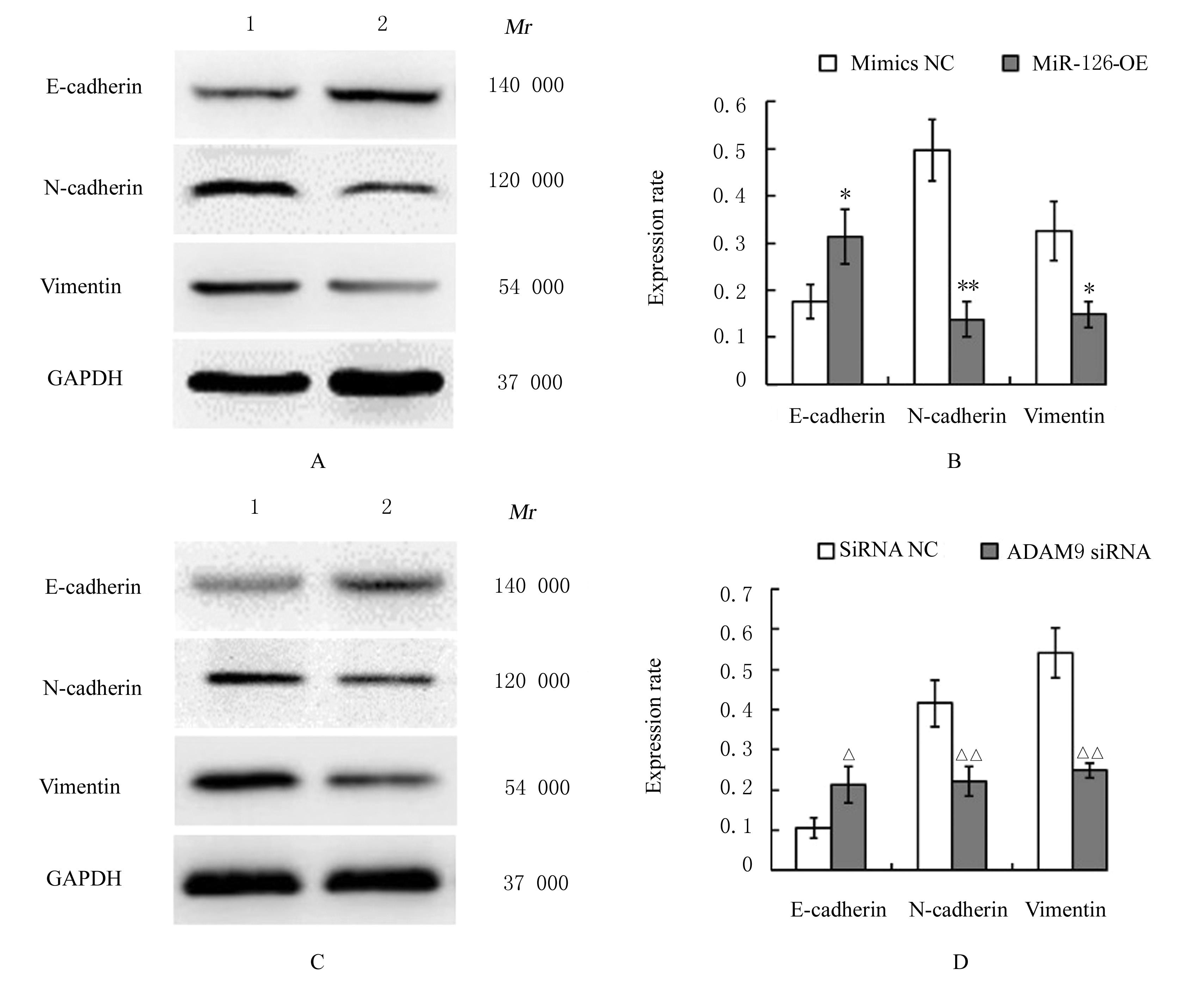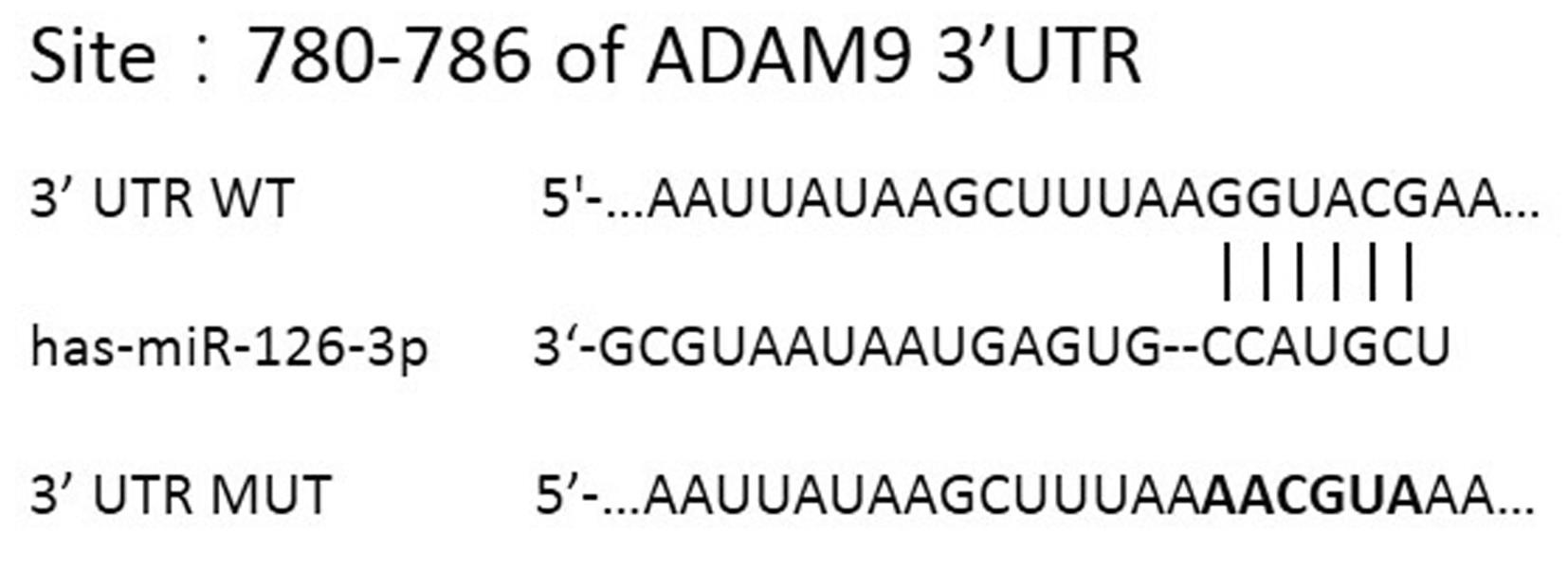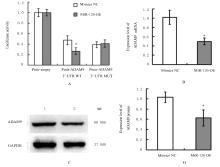Journal of Jilin University(Medicine Edition) ›› 2024, Vol. 50 ›› Issue (2): 310-319.doi: 10.13481/j.1671-587X.20240203
• Research in basic medicine • Previous Articles
Effects of miR-126 over-expression and ADAM9 gene silencing on biological behavior of gastric cancer SGC-7901 cells and their mechanisms
Haifeng WEI,Zhiqiang NI,Yanhong WEI,Qilai WANG,Shouqing LI,Yinfu MA,Yan TAN,Yanqiu FANG( )
)
- Key Laboratory of Biotherapy and Gene Diagnosis,People’s Hospital,Jilin Province,Changchun 130021,China
-
Received:2023-03-23Online:2024-03-28Published:2024-04-28 -
Contact:Yanqiu FANG E-mail:yq.fang@163.com
CLC Number:
- R735.2
Cite this article
Haifeng WEI,Zhiqiang NI,Yanhong WEI,Qilai WANG,Shouqing LI,Yinfu MA,Yan TAN,Yanqiu FANG. Effects of miR-126 over-expression and ADAM9 gene silencing on biological behavior of gastric cancer SGC-7901 cells and their mechanisms[J].Journal of Jilin University(Medicine Edition), 2024, 50(2): 310-319.
share this article
Tab.1
Primer sequences of PCR"
| Target gene | Primer sequence |
|---|---|
| ADAM9 | F: 5'-GGAAGAGTGTGACTGTGGTAC-3' |
| R: 5'-CCTCGGCATAAAGTACCTCC-3' | |
| Hsa-miR-126 stem-loop RT primer | 5'-GTCGTATCCAGTGCAGGGTCCGAGGTATTCGCACTGGATACGACCGCATT-3' |
| MiR-126-3p | F: 5'-GTCTCGTACCGTGAGTAAT-3' |
| R: 5'-GTGCAGGGTCCGAGGT-3' | |
| U6 | F: 5'-CTCGCTTCGGCAGCACA-3' |
| R: 5'-AACGCTTCACGAATTTGCGT-3' | |
| GAPDH | F: 5'-CAATGACCCCTTCATTGACC-3' |
| R: 5'-GACAAGCTTCCCGTTCTCAG-3' |
Tab. 2
Proliferation activities of SGC-7901 cells in various groups at different time points"
| Group | Proliferation activity of SGC-7901 cells | |||
|---|---|---|---|---|
| (t/h)0 | 24 | 48 | 72 | |
| Mimics NC | 0.15±0.03 | 0.34±0.08 | 0.57±0.11 | 1.26±0.12 |
| MiR-126-OE | 0.13±0.04 | 0.23±0.07 | 0.28±0.12* | 0.85±0.13* |
| SiRNA NC | 0.16±0.02 | 0.36±0.04 | 0.73±0.14 | 1.79±0.25 |
| ADAM9 siRNA | 0.17±0.06 | 0.31±0.05 | 0.40±0.09△ | 0.79±0.11△△ |
| 1 | LI H Q, ZHANG H, ZHANG H J, et al. Survival of gastric cancer in China from 2000 to 2022: a nationwide systematic review of hospital-based studies[J]. J Glob Health, 2022, 12: 11014. |
| 2 | SI L H, YANG Z C, DING L, et al. Regulatory effects of lncRNAs and miRNAs on the crosstalk between autophagy and EMT in cancer: a new era for cancer treatment[J]. J Cancer Res Clin Oncol, 2022, 148(3): 547-564. |
| 3 | 龚 瑜, 杨其昌, 袁荣华, 等. 胃癌组织与血清miR-126的表达及临床意义[J]. 癌变·畸变·突变,2017, 29(4): 272-276, 283. |
| 4 | FENG R H, SAH B K, LI J F, et al. miR-126: an indicator of poor prognosis and recurrence in histologically lymph node-negative gastric cancer[J]. Cancer Biomark, 2018, 23(3): 437-445. |
| 5 | HAOYUAN M A, YANSHU L I. Structure, regulatory factors and cancer-related physiological effects of ADAM9[J]. Cell Adh Migr, 2020, 14(1): 165-181. |
| 6 | CHANDRASEKERA P, PERFETTO M, LU C Y, et al. Metalloprotease ADAM9 cleaves ephrin-B ligands and differentially regulates Wnt and mTOR signaling downstream of Akt kinase in colorectal cancer cells[J]. J Biol Chem, 2022, 298(8): 102225. |
| 7 | LIN Y S, HSIEH C Y, KUO T T, et al. Resveratrol-mediated ADAM9 degradation decreases cancer progression and provides synergistic effects in combination with chemotherapy[J]. Am J Cancer Res, 2020, 10(11): 3828-3837. |
| 8 | GAO H F, XU J J, QIAO F, et al. Depletion of hsa_circ_0000144 suppresses oxaliplatin resistance of gastric cancer cells by regulating miR-502-5p/ADAM9 axis[J]. Onco Targets Ther, 2021, 14: 2773-2787. |
| 9 | SOOFIYANI S R, HOSSEINI K, EBRAHIMI T,et al. Prognostic value and biological role of miR-126 in breast cancer[J]. Microrna, 2022, 11(2): 95-103. |
| 10 | YU J, FAN Q Q, LI L L. The MCM3AP-AS1/miR-126/VEGF axis regulates cancer cell invasion and migration in endometrioid carcinoma[J]. World J Surg Oncol, 2021, 19(1): 213. |
| 11 | YANG Q Y, YU Q, ZENG W Y, et al. Killing two birds with one stone: miR-126 involvement in both cancer and atherosclerosis[J]. Eur Rev Med Pharmacol Sci, 2022, 26(17): 6145-6168. |
| 12 | 蒋莉萍, 赖铭裕, 蒋茂芹, 等. miR-126与靶基因GOLPH3在胃癌中的表达及其机制[J]. 实用医学杂志, 2020, 36(5): 623-627. |
| 13 | 杜 昕, 曲 泽, 赵选忠, 等. miRNA-126和K-Ras及MMP-7在胃癌中的表达及其相关性分析[J]. 实用肿瘤学杂志, 2021, 35(1): 23-27. |
| 14 | 魏海峰, 倪志强, 王起来, 等. 人胃癌组织中微小RNA-126和解整合素-金属蛋白酶9的表达及其与临床病理参数的相关性[J].中国医药, 2023, 18(11): 1678-1682. |
| 15 | HAOYUAN M A, YANSHU L I. Structure, regulatory factors and cancer-related physiological effects of ADAM9[J]. Cell Adh Migr, 2020, 14(1): 165-181. |
| 16 | MYGIND K J, SCHWARZ J, SAHGAL P, et al. Loss of ADAM9 expression impairs β1 integrin endocytosis, focal adhesion formation and cancer cell migration[J]. J Cell Sci, 2018, 131(1): jcs205393. |
| 17 | 朱莉金, 罗 琰, 贾清玉, 等. ADAM9在实体肿瘤生物学中的相关研究进展[J]. 临床医学进展, 2020(10): 2270-2280. |
| 18 | ORIA V O, LOPATTA P, SCHMITZ T,et al. ADAM9 contributes to vascular invasion in pancreatic ductal adenocarcinoma[J].Mol Oncol,2019,13(2):456-479. |
| 19 | UENO M, SHIOMI T, MOCHIZUKI S, et al. ADAM9 is over-expressed in human ovarian clear cell carcinomas and suppresses cisplatin-induced cell death[J]. Cancer Sci, 2018, 109(2): 471-482. |
| 20 | ZHOU C C, LIU J B, LI Y,et al. microRNA-1274a,a modulator of sorafenib induced a disintegrin and metalloproteinase 9 (ADAM9) down-regulation in hepatocellular carcinoma[J].FEBS Lett,2011,585(12): 1828-1834. |
| 21 | OH S, PARK Y, LEE H J, et al. A disintegrin and metalloproteinase 9 (ADAM9) in advanced hepatocellular carcinoma and their role as a biomarker during hepatocellular carcinoma immunotherapy[J]. Cancers, 2020, 12(3): 745. |
| 22 | CHENG X S, SHEN T, LIU P, et al. miR-145-5p is a suppressor of colorectal cancer at early stage, while promotes colorectal cancer metastasis at late stage through regulating AKT signaling evoked EMT-mediated anoikis[J]. BMC Cancer, 2022, 22(1): 1151. |
| 23 | CHEN Y, FANG Y, LI L, et al. Exosomal miR-22-3p from mesenchymal stem cells inhibits the epithelial-mesenchymal transition (EMT) of melanoma cells by regulating LGALS1[J]. Front Biosci,2022,27(9): 275. |
| 24 | VAN KAMPEN J G M, VAN HOOIJ O, JANSEN C F,et al. miRNA-520f reverses epithelial-to-mesenchymal transition by targeting ADAM9 and TGFBR2[J]. Cancer Res, 2017, 77(8): 2008-2017. |
| 25 | DONG Y Y, WU Z F, HE M Y,et al.ADAM9 mediates the interleukin-6-induced Epithelial-Mesenchymal transition and metastasis through ROS production in hepatoma cells[J]. Cancer Lett, 2018, 421: 1-14. |
| 26 | LE T T, HSIEH C L, LIN I H, et al. The ADAM9/UBN2/AKR1C3 axis promotes resistance to androgen-deprivation in prostate cancer[J]. Am J Cancer Res, 2022, 12(1): 176-197. |
| [1] | Yanhong WEI,Chenxue YANG,Guangmin YANG,Shuai SONG,Ming LI,Haijiao YANG,Haifeng WEI. Inhibitory effect of downregulating HMGB2 expression on epithelial-mesenchymal transition of liver cancer LM3 cells and its AKT/mTOR signaling pathway mechanism [J]. Journal of Jilin University(Medicine Edition), 2024, 50(1): 143-149. |
| [2] | Jia ZHOU,Zhidong QIU,Zhe LIN,Guangfu LYU,Jiaming XU,He LIN,Kexin WANG,Yuchen WANG,Xiaowei HUANG. Effect of chelerythrine on migration, invasion, and epithelial-mesenchymal transition of human ovarian cancer SKOV3 cells [J]. Journal of Jilin University(Medicine Edition), 2024, 50(1): 25-32. |
| [3] | Tao HE,Zhenjiang LI,Bingqian DING. Influence of ligustrazine on growth of glioma stem cells subcutaneous xenografts in nude mice, TGF-β signaling pathway, and epithelial-mesenchymal transiton [J]. Journal of Jilin University(Medicine Edition), 2023, 49(6): 1437-1444. |
| [4] | Hui YE,Zhe SUN,Liting ZHOU,Wen QI,Lin YE. Bioinformatics analysis on differentially expressed genes in lung adenocarcinoma based on GEO and TCGA Databases [J]. Journal of Jilin University(Medicine Edition), 2023, 49(6): 1491-1503. |
| [5] | Manying OU,Chunxia HU,Yueping LI. Effect of expression of microtubule inhibitory assembly protein 1 in placenta tissue of pre-eclampsia patients on trophoblast cells and its mechanism [J]. Journal of Jilin University(Medicine Edition), 2023, 49(6): 1519-1527. |
| [6] | Dandan WANG,Ning ZHOU,Dongqin LIU,Jie ZHAO,Chao LIANG,Juanjuan DAI,Yan WU. Effect of miR-491-5p over-expression on proliferation and migration of human nasopharyngeal carcinoma HONE-1 cells [J]. Journal of Jilin University(Medicine Edition), 2023, 49(5): 1134-1139. |
| [7] | Haikang CUI,Xudong ZHANG,Xiaoning LI,Xi YANG,Lan YANG,Wenjie ZHANG. Bioinformatics analysis on predition effect of subtypes of cell pyroptosis and APOD on prognosis of gastric cancer patients [J]. Journal of Jilin University(Medicine Edition), 2023, 49(5): 1268-1279. |
| [8] | Rui LI,Xiaodong TAN,Yaoyuan HU. Inhibitory effect of pachylic acid on migration, invasion, and epithelial-mesenchymal transition of human pancreatic cancer PANC-1 cells [J]. Journal of Jilin University(Medicine Edition), 2023, 49(2): 315-323. |
| [9] | Meng QYU,Hong ZHENG,Yan LI,Boxue CHEN,Yuzhu JIANG,Shenggao WANG,Chunyan YU,Zhiheng DONG. Inhibitory effect of fermented red ginseng total saponins high glucose-induced renal tubular cell epithelial-mesenchymal transition and its mechanism [J]. Journal of Jilin University(Medicine Edition), 2022, 48(5): 1182-1189. |
| [10] | Juan CAO,Weibo LI,Xiu GUO,Bo LI,Chunling DONG. Effects of targeted silencing of heat shock protein 27 on invasion and migration of oral squamous cell carcinoma CAL27 cells and their mechanisms [J]. Journal of Jilin University(Medicine Edition), 2021, 47(4): 971-977. |
| [11] | Ying YANG, Wei ZHAO, Dan LYU. Effect of C19ORF12 on proliferation and chemo-sensitivity of gastric cancer MKN45 cells and its mechanism [J]. Journal of Jilin University(Medicine Edition), 2021, 47(3): 687-693. |
| [12] | Mingbo JIA,Ying SUN,Ying WANG,Yanke SONG,Liyan ZHAO. Inhibitory effect of nitidine chloride on epithelial-mesenchymal transition of glioma cells through JAK2/STAT3 signaling pathway [J]. Journal of Jilin University(Medicine Edition), 2021, 47(1): 73-81. |
| [13] | Xia LI,Yi YU,Haiwei ZUO,Fengjuan ZHOU,Yong XIN. Inhibitory effect of circRNA on colorectal cancer and its bioinformatics analysis [J]. Journal of Jilin University(Medicine Edition), 2020, 46(6): 1283-1287. |
| [14] | WEI Xujing, LI Lin, ZHANG Hongzhen, WANG Jing, XU Jing. Effects of LncRNA CCAT1 on proliferation,invasion and migration of endometrial cancer cells through TGF-β1/smad signaling pathway [J]. Journal of Jilin University(Medicine Edition), 2020, 46(05): 1016-1022. |
| [15] | ZHOU Ning, WU Rui, MA Zhenkai, CHEN Weiwei, LI Xuelin, GONG Kaikai, YANG Lijuan, DAI Juanjuan, WU Yan. Effects of down-regulation of ADAR1 expression on proliferation, migration and epithelial-mesenchymal transition of human lung cancer cells [J]. Journal of Jilin University(Medicine Edition), 2020, 46(04): 669-674. |
|
||













